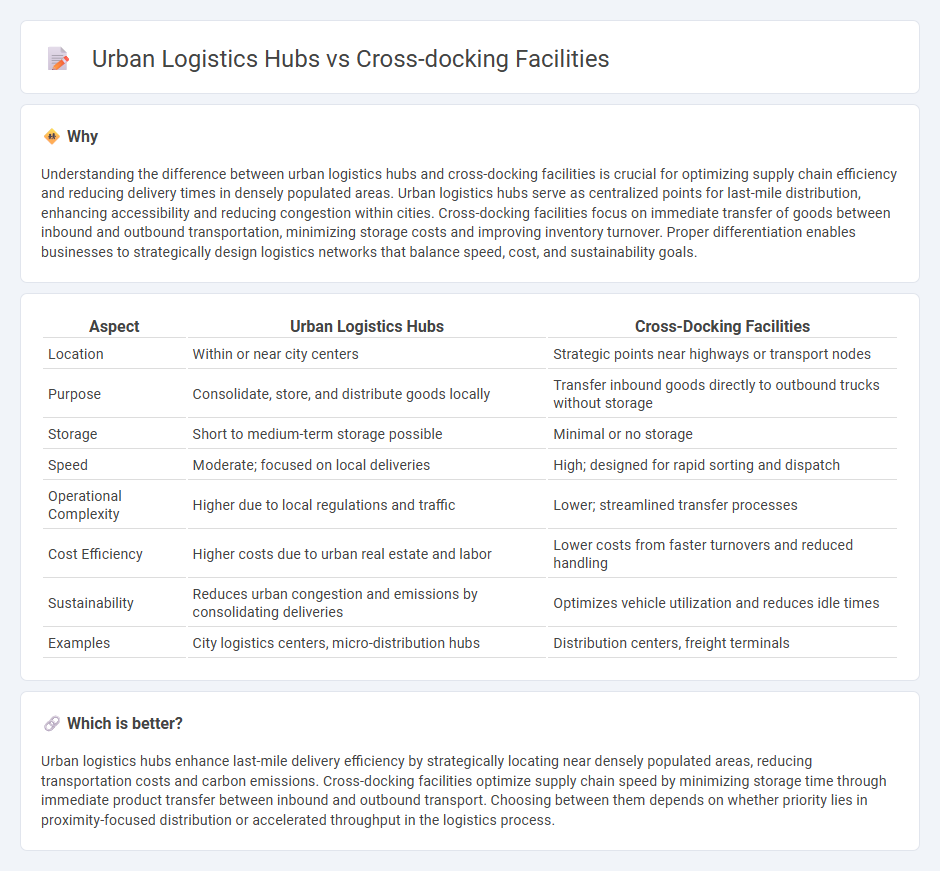
Urban logistics hubs streamline last-mile delivery by consolidating shipments closer to dense city centers, reducing traffic congestion and delivery times. Cross-docking facilities focus on rapid transfer of goods from inbound to outbound transportation, minimizing storage and speeding up supply chains. Explore the advantages and strategic roles of each to optimize your logistics operations.
Why it is important
Understanding the difference between urban logistics hubs and cross-docking facilities is crucial for optimizing supply chain efficiency and reducing delivery times in densely populated areas. Urban logistics hubs serve as centralized points for last-mile distribution, enhancing accessibility and reducing congestion within cities. Cross-docking facilities focus on immediate transfer of goods between inbound and outbound transportation, minimizing storage costs and improving inventory turnover. Proper differentiation enables businesses to strategically design logistics networks that balance speed, cost, and sustainability goals.
Comparison Table
| Aspect | Urban Logistics Hubs | Cross-Docking Facilities |
|---|---|---|
| Location | Within or near city centers | Strategic points near highways or transport nodes |
| Purpose | Consolidate, store, and distribute goods locally | Transfer inbound goods directly to outbound trucks without storage |
| Storage | Short to medium-term storage possible | Minimal or no storage |
| Speed | Moderate; focused on local deliveries | High; designed for rapid sorting and dispatch |
| Operational Complexity | Higher due to local regulations and traffic | Lower; streamlined transfer processes |
| Cost Efficiency | Higher costs due to urban real estate and labor | Lower costs from faster turnovers and reduced handling |
| Sustainability | Reduces urban congestion and emissions by consolidating deliveries | Optimizes vehicle utilization and reduces idle times |
| Examples | City logistics centers, micro-distribution hubs | Distribution centers, freight terminals |
Which is better?
Urban logistics hubs enhance last-mile delivery efficiency by strategically locating near densely populated areas, reducing transportation costs and carbon emissions. Cross-docking facilities optimize supply chain speed by minimizing storage time through immediate product transfer between inbound and outbound transport. Choosing between them depends on whether priority lies in proximity-focused distribution or accelerated throughput in the logistics process.
Connection
Urban logistics hubs optimize last-mile delivery by centralizing goods close to consumption points, while cross-docking facilities streamline inventory flow by minimizing storage time through direct transfer between inbound and outbound transport. The integration of these two enables efficient consolidation and rapid distribution of shipments, reducing delivery times and transportation costs in densely populated areas. Advanced data analytics and real-time tracking systems enhance coordination between hubs and cross-docking centers, ensuring seamless inventory movement and improved supply chain responsiveness.
Key Terms
Transshipment
Cross-docking facilities streamline the transshipment process by minimizing storage time and enabling rapid sorting and redistribution of goods, which enhances supply chain efficiency. Urban logistics hubs serve as central points within city environments, facilitating transshipment by integrating various transportation modes to support last-mile delivery and reduce congestion. Explore the distinctions and synergies between these solutions to optimize urban freight transshipment strategies.
Last-mile delivery
Cross-docking facilities streamline inventory flow by transferring goods directly from inbound to outbound transportation, reducing storage time and enhancing supply chain efficiency. Urban logistics hubs concentrate on optimizing last-mile delivery by positioning inventory closer to dense customer areas, minimizing delivery times and costs. Explore how integrating these strategies can revolutionize urban last-mile logistics and improve delivery performance.
Inventory holding
Cross-docking facilities minimize inventory holding by rapidly transferring goods from inbound to outbound transportation, reducing storage time and costs significantly. Urban logistics hubs, while also optimizing delivery processes, often maintain some level of inventory to meet local demand quickly and support last-mile distribution. Explore the operational advantages and inventory strategies of both systems to enhance your supply chain efficiency.
Source and External Links
Understanding cross-docking: A comprehensive guide - Maersk - Cross-docking facilities are designed for the rapid transfer of goods from inbound to outbound transport with minimal or no storage, focusing on optimized facility layout, advanced scheduling, and real-time information systems to maximize efficiency.
How Does Cross Docking Work in Industrial Real Estate? - Cross-dock facilities feature loading doors on opposite sides of the building to enable direct movement of goods from incoming to outgoing vehicles, reducing handling time and storage needs, but require sufficient space, equipment, and infrastructure to operate effectively.
How Cross-Dock Warehouses Work: Guide To Cross ... - Shopify - Cross-dock warehouses act as transfer hubs where goods are quickly unloaded, sorted, and reloaded onto outbound vehicles, minimizing storage costs and speeding up delivery times through dedicated inbound and outbound areas and advanced material handling technology.
 dowidth.com
dowidth.com